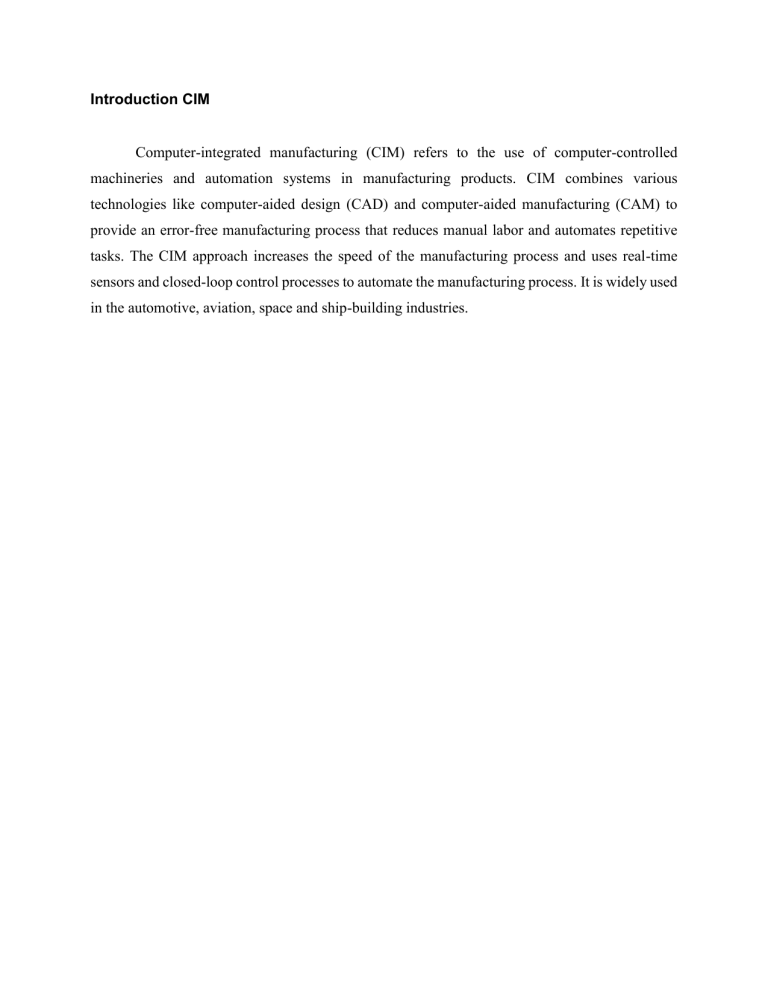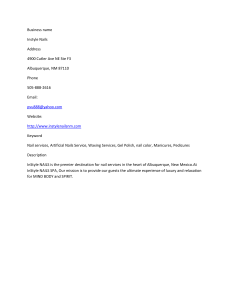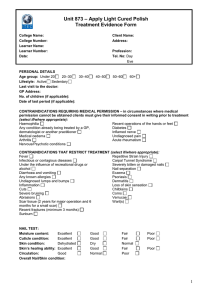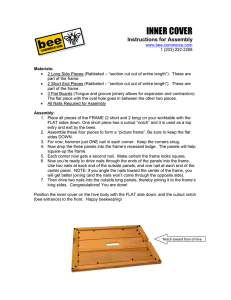
Introduction CIM Computer-integrated manufacturing (CIM) refers to the use of computer-controlled machineries and automation systems in manufacturing products. CIM combines various technologies like computer-aided design (CAD) and computer-aided manufacturing (CAM) to provide an error-free manufacturing process that reduces manual labor and automates repetitive tasks. The CIM approach increases the speed of the manufacturing process and uses real-time sensors and closed-loop control processes to automate the manufacturing process. It is widely used in the automotive, aviation, space and ship-building industries. TRUE SDN. BHD. HANG ON ME Introduction company Type of industry Organization Chart MANAGER: Ir. Muhammad Taufiq Idzhan Bin Abu Hassan MANAGMENT: Anis Yasmin Binti Mohd Zamri ENGINEER: Ir. Muhammad Azim Bin Adnan PRODUCTION: Muhammad Farhan Hakim Bin Zairi Background A nail consists of a metal rod or shank, pointed at one end and usually having a formed head at the other, that can be hammered into pieces of wood or other materials to fasten them together. A nail is usually made of steel, although it can be made of aluminum, brass, or many other metals. The surface can be coated or plated to improve its corrosion resistance, gripping strength, or decorative appearance. The head, shank, and point may have several shapes based on the intended function of the nail. Of the nearly 300 types of nails made in the United States today, most are used in residential housing construction. The average wood frame house uses between 20,000 and 30,000 nails of various types and sizes. Nails are divided into three broad categories based on their length. In general nails under 1 inch (2.5 cm) in length are called tacks or brads. Nails 1-4 inches (2.5-10.2 cm) in length are called nails, while those over 4 inches (10.2 cm) are some-times called spikes. These categories are roughly defined, and there is considerable crossover between them. The length of a nail is measured in a unit called the penny. This term comes from the use of nails in England in the late 1700s when it referred to the price of one hundred nails of that size. For example, a "ten penny nail" would have cost ten pennies per hundred. The symbol for penny is "d," as in 10d. This designation is believed to go back to the time of the Roman Empire when a similar form of measurement for hand-forged nails involved a common Roman coin known as the denarius. Today the term penny only defines the length of a nail and has nothing to do with the price. The shortest nail is 2d which is 1 inch (2.5 cm) long. A 10d nail is 3 inches (7.6 cm) long, and a 16d nail is 3.5 inches (8.9 cm) long. Between 2d and 10d the nail length increases 0.25 inch (0.64 cm) for each penny designation. Beyond 10d there is no logical progression to the lengths and designations. Nails may have been used in Mesopotamia as early as 3500 B.C. and were probably made of copper or bronze. Later, iron was used to make nails. Early nails were shaped, or forged, with hammers. They were usually made one at a time, and were consequently scarce and expensive. By the 1500s a machine was developed which produced long, flattened strips of iron, called nail rods. These strips could then be cut into lengths, pointed, and headed. Nails were so valuable in the early American settlements that in 1646 the Virginia legislature had to pass a measure to prevent colonists from burning down their old houses to reclaim the nails when they moved. Two early nail-making machines were patented by Ezekial Reed of the United States in 1786 and Thomas Clifford of England in 1790. These machines cut tapered pieces from flat iron sheet, then flattened the head. In rural areas, black-smiths continued to make nails from wrought iron right into the 20th century. The first machine to make nails from metal wire was introduced in the United States in about 1850, and this technique is now used to make most of the nails today. History nails Most of the 300 different types of nails produced in the United States today require no new design work. Once a nail has been designed, forming dies and processes are developed for its manufacture, and the nail is produced in quantity. Most nails have a broad, circular head. Finishing nails have a narrow, tapered head which allows them to be countersunk below the surface of the material and covered over to produce a smooth finish. Upholstery nails have decorative heads. Double-headed nails are used to fasten wood forms used in concrete pouring. The nail is driven in up to the first head, leaving the second head protruding. The protruding head allows the nails to be easily removed and the forms quickly dismantled once the concrete has hardened. The shank is usually designed to be round and smooth. Shanks with serrations, annular grooves, spiral flutes, or helical threads are used when a stronger, more permanent grip is required. Thermoplastic coatings may also be added to the shaft. These coatings heat up through friction while the nail is being driven, then quickly cool and set to lock the nail in place. The diameter of the shank is determined by the type of nail. Most nails, called common nails, have a relatively large diameter. Box nails, originally used to make thin-walled boxes, have a smaller diameter shank than common nails. Finishing nails have a very small diameter shank in order to make the smallest hole possible. The most typical nail point is a four-sided tapered cut called a diamond point. Other nails may have a blunter point to prevent splitting certain woods. Chisel points, barbed points, needle points, and many others are sometimes used on specialty nails. As new building materials become available, nail manufacturers work to develop new nails. There are special nails for tile roofing, hardwood flooring, shingles, rain gutters, wall board, sheet metal, and concrete. Some new nails are designed to be driven by air-powered nail guns rather than by a hammer. There have even been new nails designed for specific applications in the aerospace industry. This massive, mid-19th-centvry nail cutting machine used a shearing action to cut nails from bar iron. (From the collections of Henry Ford Museum & Green-field Village.)This massive, mid-19th-centvry nail cutting machine used a shearing action to cut nails from bar iron. (From the collections of Henry Ford Museum & Green-field Village.) Nails are essential to the construction of wood-framed buildings. This, however, was not always the case. Until the late 18th century, Americans built wooden buildings using heavy timber frames. At places where these massive timbers had to hold together, one end of a post or beam would be cut down to form a tongue ("tenon") and fitted into a hole ("mortise") cut in the adjoining beam. Additional strength could be added by driving wooden pegs through auger holes in the joined timbers. The skill and labor involved in such construction was considerable; carpenters had to be highly skilled individuals and, as such, commanded high prices in colonial America. Until the end of the 18th century, nails were imported from England or made by local blacksmiths. The smithy, or often his apprentice, took a piece of bar iron maybe 5 feet long and 0.06-0.25 inch in diameter. Holding one end he heated the other, laid it on the anvil and, using the flat face of his hammer, tapered all four sides to about an inch from the end. He then used the peen, or sharpened end of his hammer, or a hardy, a wedge-shaped attachment to his anvil, to cut a notch in the rod. He thrust the sharpened end of the rod into a tapered hole in his anvil and snapped off the short nail. Then he flattened the end of the nail with four or five quick strikes of the hammer and popped it out of the anvil hole with a quick, upward strike at the point. Between 1790 and 1830, several mechanical devices were developed in Europe and the United States to speed the production and lower the cost of nails. It is not entirely coincidental, therefore, that the balloon-framed house, which relied on two-by-fours held together by nails, was invented in the early 1830s in Chicago. The balloon-frame system required much less skill and labor in carpentry and made use of mass-produced nails. Product A small metal spike with a broadened flat head, driven into wood to join things together or to serve as a hook. Our company can produce 700 nails per minutes using nail making machine. We also makes four different sizes of nails with same shape. The size are : Material Used Most nails are made of steel. Aluminum, copper, brass, bronze, stainless steel, nickel, silver, zinc , and iron are also used. Galvanized nails are coated with zinc to give them added corrosion resistance. Blued steel nails are subjected to a flame to give them a bluish oxide finish that provides a certain amount of corrosion resistance. So-called cement-coated nails are actually coated with a plastic resin to improve their grip. Some brads are given a colored enamel coating to blend in with the color of the material they are fastening. Quality Control Raw materials must meet certain standards for chemical composition, yield strength, hardness, corrosion resistance and other properties. These are usually certified by the company supplying the wire, and may be independently checked by the nail manufacturer. During manufacture, nails must also meet certain specifications regarding dimensions and properties. These are achieved using a method known as statistical process control, which periodically samples the dimensions and properties of the nails being produced and evaluates any changes through statistical analysis techniques Prospect of the Company The demand for mass-produced commodity nails is dependent on the fluctuations in the housing market, which varies with the economy. Demand for these nails is also subject to competition from foreign manufacturers, further reducing profits. The demand for specialty nails, on the other hand, is expected to continue to grow and be profitable. New building materials, such as composite wood-fiber and cement-based siding and roofing, require new specialty nails. New corrosion-resistant coatings for nails are also being developed. One unique new nail market is the result of the increase in building restoration and preservation efforts throughout the country. One nail factory in Massachusetts makes oldfashioned cut nails. They estimate that 20% of their work is in producing a variety of these nails for use in authentic building restoration projects. Company Layout Flow chart Wire Rod Nail making machine Polishing and Inspection machine Robot Arm Wire Drawing Machine Packaging Machine Costing Mechanism Transfer TRUE Sdn Bhd used automated production line because its required large production and it can do different operation. There are two types of mechanism transfer which is straight and circular pattern . To manufacture nails , TRUE Sdn Bhd used straight pattern and continuous motion because it can transport the nails to another stations and able to produced in mass production . A) Single pattern Segmented In-Line Configurations For the layout , TRUE Sdn Bhd used u-shaped work cell to allowed us to visual control and management according to the production . A single person can handle both the cell input feeding and output . These layouts provide convenient foundation for one piece flow and easy to manage if we have problem . The floor space is generally fewer with a U cell than stretched line (including inventories and supplies), walk distances are also reduced, as they are Muda (waste). U-shaped layout Process Manufacturing Most nails are made from coils of metal wire. The wire is fed into a nail-making machine which can produce up to 700 nails per minute. The nails may then be further twisted or formed, cleaned, finished, and packaged. Forming Wire is drawn from a coil and fed into the nail-making machine where it is gripped by a pair of gripper dies. The shape of the head of the nail has been machined into the end of the dies. While the dies clamp the wire in place, the free end of the wire is struck by a mechanical hammer. This deforms the end of the wire into the die cavity to form the head of the nail. With the wire still clamped in the dies, a set of shaped cutters strike the opposite end of the nail, forming the point and cutting the nail free from the rest of the wire coming off the coil. The dies open and an expelling mechanism knocks the nail into a collection pan below the machine. The free end of the wire is drawn from the coil and fed into the machine. The cycle then begins again. Additional forming Nails with helical twists, serrations, or other surface configurations are fed into other machines that roll, twist, stamp, or cut the required forms. This may be a purely mechanical process or may require heating the material before forming. Finishing The nails are cleaned in a rotating barrel filled with hot caustic soda. This Nail removes any oil from the forming machine and cleans up any small metal scraps, or nipping’s, that might be clinging to the nails. Many nails are given a final bright finish before being packaged. This is accomplished by placing the nails in a rotating drum of hot sawdust to lightly polish the surface of the nails. Other nails may be passed through an open flame in an oven to give them a blued finish. Galvanized nails are dipped into a tank of molten zinc in a process called hot-dip galvanizing. A zinc coating may also be applied by heating the nails to about 570°F (300°C) in a closed container filed with a powder composed of zinc dust and zinc oxide. Other coated nails are either dipped or sprayed to obtain their final finish. Depending on the tolerances desired, some specialty nails may also require an additional heat treating step. Packaging Magnetic elevators convey the finished nails to weighing machines which drop them into open cardboard boxes. As they are dropped in, a magnetic field aligns them so they stack in neat rows. After they are packaged, the nails are demagnetized. Nails are usually sold in boxes of 1, 5, 10, 25, and 50 pounds. Smaller nails, such as brads, are sold in 2-ounce or 4-ounce boxes and are packaged without being magnetically aligned. Computer-Integrated Manufacturing System ( CIMS) True Sdn. Bhd. used CIM system is a manufacturing model for the unmanned factory of the future. It is related to automation, material handling, system integration, CNC machining and robotics. True Sdn Bhd system is designed for flexible manufacturing and allows a wide range of machine tools, automation devices and software to be integrated. It has an open system concept whereby manufacturing software such as CAD/CAM, databases, MRP are easily integrated. Components of CIMS Machine Wire drawing machine True Sdn Bhd. use Wire drawing is a metalworking process used to reduce the cross-section of a wire by pulling the wire through a single, or series of, drawing die(s). There are many applications for wire drawing, including electrical wiring, cables, tension-loaded structural components, springs, paper clips, spokes for wheels, and stringed musical instruments. Although similar in process, drawing is different from extrusion, because in drawing the wire is pulled, rather than pushed, through the die. Drawing is usually performed at room temperature, thus classified as a cold working process, but it may be performed at elevated temperatures for large wires to reduce forces. Nail making machine A function of wire nail making machine cuts a coil, steel wire and converts into the nails and make wire nail completely. We are production various types of nail making machines as per customer requirement machines. Currently , we use z94-6c as our machine because the machine specification is suitable for our production . Specification for z94-6c machine z94-6c nails machine Polishing and Inspection Machine Once the nail making machine forms the cap, the coil needs to be polished for it to qualify as a nail. The nail polishing machine makes the nail brighter by mixing it with sawdust and stirs it synchronously. Hence will help you achieve a required degree of brightness. Polishing Machine Auto cad True Sdn Bhd. company used CatiaV5 to design the shape of nails started from scratch or from 2D sketches . It also can do the analysis and provides simulation capability within the design environment . Stress and vibration analysis on complex assemblies enabling design engineers to simulate and validate assemblies that include surfaces, solids, and wireframe geometries. It can Reduced costs resulting from the ability to detect problems early in the design process . Benefits: 60% improvement in the product design/analysis cycle time compared to non-integrated design/analysis solutions User-friendly and comprehensive analysis environment enables both designers and engineers to carry out simulation Reduced costs resulting from the ability to detect problems early in the design process Productivity gains due to a common environment which enables seamless design and analysis A programmable logic controller( PLC) TRUE Sdn Bhd use SIMATIC S7-1500 PLC to monitor and control production processes and building systems . A system consisting of various automated manufacturing functions linked together so that the entire product process is automated. PLC system allows the production planner and scheduler, foremen and accountant to use the common database that been used by product designer and manufacturing engineer. In our company , we use PLC for control of manufacturing processes, such as assembly lines, or robotic devices, or any activity that requires high reliability control and ease of programming and process. Advantages : Troubleshooting is simpler with PLC’s as they have been provided with fault indicators and written fault information displayed on the screen. Hardware and software of the PLC are designed for easy use by the plant technician and electricians. Ease of maintenance Quick installation Automated Material Handling For the work part mechanism , TRUE Sdn Bhd use Belt-Driven Linear Transfer System to carry the nails to another station and the process of conveying materials have become easy and quick because of this efficient mechanical device. Conveyor Belt After finish manufacture , TRUE Sdn Bhd used wooden pallet and box to reduce the product damage and transport them for sale . Wooden Pallet Box Currently , TRUE Sdn Bhd transport the product using fork lift form packaging station to truck . TRUE Sdn Bhd use this transport system because it used to lift and move materials over short distances. The Capacities from 450 kg up to 4500 kg it can bring in a lot of our production . Forklift Robotics In our factory , TRUE Sdn Bhd use robotic arms to transport raw materials from storage to drawing machines . This robot will pull the wire from storage using the gripper . The robots can substitute for humans in hazardous work environments and Consistency and accuracy not attainable by humans . so , the company can repetitive work cycle to produce mass production . This robots is very Intelligent control that can responds to sensor inputs, makes decisions, communicates with humans . The robots that we have use an electric drive system to make sure the accuracy and repeatability production . It also use small space that can save our space . Robotic arm The robot will pull wire rod using grippers to grasp and manipulate objects during work cycle. The two-fingers mechanical gripper for grasping rotational parts .so, our wire is very suitable for the gripper. It will stable in linear path. We are able to extend very far and little work space Two-finger mechanical gripper Improvement 1) Upgrade 2 nail making machines. Buy a secondhand machine but good quality. 1 machine can produce 700 units/minutes so 2 machines can produce 1200 units/minute. The profit will improve 58%. 2) Currently, TRUE Sdn Bhd was only operate 10 hours per day that means only 1 shift. With this operational hour our company can gain profit around RM 1076400. For this reason we want to increase our production rate by extend our production period from 10 hours to 18 hours a day. So the company will provide 2 shifts in one day. From this change our company can generate more profit. the profit will improve 55% from the previous profit. Previous working schedule. Working day Working hour Break Monday 8:00 a.m – 7:00 p.m 12:00 p.m – 1:00 p.m Tuesday 8:00 a.m – 7:00 p.m 12:00 p.m – 1:00 p.m Wednesday 8:00 a.m – 7:00 p.m 12:00 p.m – 1:00 p.m Thursday 8:00 a.m – 7:00 p.m 12:00 p.m – 1:00 p.m Friday 8:00 a.m – 7:00 p.m 12:00 p.m – 1:00 p.m Saturday 8:00 a.m – 7:00 p.m 12:00 p.m – 1:00 p.m Working day Working hour Break Monday 8:00 a.m – 7:00 p.m 12:00 p.m – 1:00 p.m Tuesday 8:00 a.m – 7:00 p.m 12:00 p.m – 1:00 p.m Wednesday 8:00 a.m – 7:00 p.m 12:00 p.m – 1:00 p.m Thursday 8:00 a.m – 7:00 p.m 12:00 p.m – 1:00 p.m Friday 8:00 a.m – 7:00 p.m 12:00 p.m – 1:00 p.m Saturday 8:00 a.m – 7:00 p.m 12:00 p.m – 1:00 p.m Working day Monday Tuesday Wednesday Thursday Friday Saturday Working hour 8:00 p.m – 7:oo a.m 8:00 p.m – 7:oo a.m 8:00 p.m – 7:oo a.m 8:00 p.m – 7:oo a.m 8:00 p.m – 7:oo a.m 8:00 p.m – 7:oo a.m Break 12:00 a.m – 1:00 a.m 12:00 a.m – 1:00 a.m 12:00 a.m – 1:00 a.m 12:00 a.m – 1:00 a.m 12:00 a.m – 1:00 a.m 12:00 a.m – 1:00 a.m Suggested working schedule. 3) Providing custom size nails according to customer order because our company only provide standard size nails. Furthermore, nail making machine can providing variety size of nails and shape. Custom size nail will be different in length, diameter and height 4) For our current operational process we produce the nails based on our previous order from the customer. Because of this reason, sometimes our production rate exceed the customer demand. This contribute to the increase in our inventory that lead to company lose. From this problem we decided to apply Kanban system to our company. Below are the general idea of Kanban system. The implementation of Kanban system also improve how our staffs work during production time. With the use of Kanban card the workers can supervise the quantiy of raw material was synchronize the nail production. Beside that, Kanban card also help the workers to detect any problem occour during operational hour. Below are the illustration of how Kanban card was used. Discussion Computer-integrated manufacturing (CIM) is a system consisting of software covering many business processes, including integration of automated assignment and reporting of factory floor operations through machine and material handling equipment sensors and software. CIM covers our company TRUE Sdn. Bhd. in resource planning (ERP) modules in a manufacturing operation, including design, purchasing, inventory, shop floor control, material requirements planning, customer order management and cost accounting. Advantages include error reduction, speed, flexibility and a high degree of integration. CIM generate ways to overcome and reduce error in our company which it’s perform inventory and operational information achieve a very high level of accuracy, CIM can perform functions with minimal human intervention and then report on the results automatically. Assignment and reporting in a CIM environment are performed automatically and immediately without any delay involved with people-based transactions. Depending on the environment, this additional speed allows operations to be performed as soon as previous work occurs without any lag time. CIM environments therefore reduce the time it takes to perform manufacturing fabrication and assembly, allowing quicker flow of product to customers and increased capacity. Once operations are assigned and reported in a CIM system, changes to various operations can also be performed more easily. CIM systems are designed to be entirely paperless, eliminating the barriers to changing operations. This flexibility, combined with the speed it can be performed, allows companies to quickly react to market conditions and then return to previous settings when market conditions change. Factory floor operations are not integrated in non-CIM situations; manufacturing operations and material usage must be reported by humans who perform transactions. CIM offers a degree of integration that enables the flexibility, speed and error reduction required to compete and lead markets. Integrating factory floor operations with enterprise software enables employees to do higher value functions for their companies. Conclusion Computer-integrated manufacturing (CIM) is the manufacturing approach of using computer to control the entire production process. This integration allows individual processes to exchange information with each order and initiate actions. Through the integration of computers, manufacturing can be faster and less error-prone, although the main advantage is the ability to create automated manufacturing processes. Even though CIM may have its share of disadvantages, but its advantages outweigh them. Regardless of its high cost, it increase productivity greatly and is one of the most important factors for the expansion of a company.




